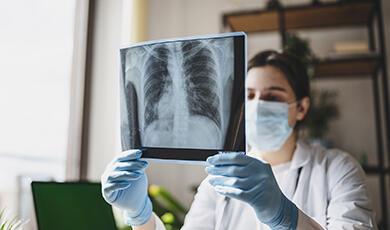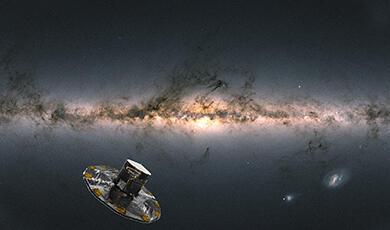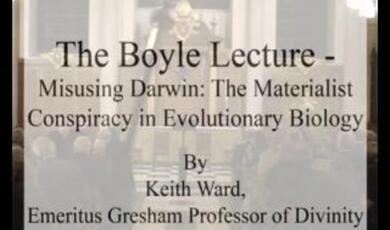The Microbial Basis of Life
Share
- Details
- Text
- Audio
- Downloads
- Extra Reading
Single-celled microbes underpin all life on Earth, and even complex organisms like humans retain a surprising amount of their microbial heritage. Life began when free molecules became encapsulated in a lipid membrane and transformed into a self-replicating entity. Subsequently, multiple cells came together, forming a remarkable symbiosis that ultimately led to all complex, eukaryotic, cells and laid the foundations for multicellular life.
Understanding this microbial legacy has some surprising implications, such as explaining why some antibiotics have unwanted side effects.
Download Text
The Microbial Basis of Life
Professor Robin May
5th October 2022
Most of us live our lives rarely thinking of the unseen teeming communities of microscopic organisms that live with, on and in us. We may, perhaps, spare a thought for them when a viral infection confines us to bed, or a long-forgotten and now spectacularly fluffy orange is discovered at the bottom of the fruit bowl, but, by and large, microbes do not feature strongly in our daily thoughts.
But in fact, microbes underpin almost every aspect of our lives. Many of the foods we eat are microbial products, from bread and beer to chocolate and cheese. Microbes shape – and sometimes even create – the ground we stand on. And all of us become a teeming microbial habitat within minutes of being born, live out our lives as an immeasurably complex ecosystem of invisible organisms and then, at the last, are decomposed and recycled by microbes.
The first life on Earth was microbial and it is highly likely that the last survivors before the planet becomes completely uninhabitable will be microbial too (more on that in a later lecture). Microbes carry out chemical reactions that no human has ever mastered, live in locations that no human could survive and are capable of destruction on a scale that no human weapon can match. From an alien perspective, the Earth is a microbial planet, upon which a tiny number of bipedal apes have recently appeared and will most likely disappear just as swiftly.
The Origins of Life
The earliest fossil evidence for potential life on our planet dates to around 3.7-3.9 billion years ago, although the interpretation of such ‘microfossils’ remains highly controversial. This is at least 600 million years after the Earth formed and it is impossible for us to be sure about how life arose spontaneously during this period. We know, though, that relatively complex molecules such as amino acids can arise spontaneously when simple chemicals (such as hydrogen and nitrogen) are exposed to the extreme conditions that would have been present in the early Earth.
We also know that some molecules, such as certain molecules made from ribonucleic acid (RNA), are capable of catalysing enzymatic reactions without the need for proteins. Today, the most well-studied group of such molecules are the self-cleaving RNAs. Chemically very similar to DNA, these long strings of RNA ‘letters’ are able to fold into complex three-dimensional shapes and then cleave themselves into specific products. It does not require a huge leap of imagination to imagine similar molecules arising on the infant Earth and acquiring the ability to not only cleave, but also replicate themselves.
‘Life’, though, requires more than simply self-replication of a single molecule. Living things are different to the media that surrounds them; they accumulate specific chemicals and discard others, store energy from sunlight or food, and build complex molecular structures. All of these things require them to have a membrane; a barrier to separate and concentrate molecules such that the chemical composition within a ‘proto-cell’ is different to that of the surrounding media. How might such a barrier have arisen on the early planet? The most likely scenario is one of molecular self-association. Broadly speaking, chemical structures are either hydrophilic (‘water loving’ – for instance, chemicals that dissolve easily like salt or sugar) or hydrophobic (literally ‘water hating’; for instance, fats and oils). When these are mixed, each type tends to self-associate, forming hydrophobic droplets within a hydrophilic solution or vice versa; a phenomenon that will be familiar to anyone who has made an oil and vinegar dressing for a salad.
Imagine, then, an early Earth, with hydrophobic molecules accumulating in the warm seas. Very rapidly, such molecules would have self-associated, creating fatty ‘bubbles’. Some of these bubbles would contain the self-catalytic molecules that are capable of replication, creating a ‘proto-cell’ that could grow and then fragment - a precursor of the lipid-encapsulated cells that are a fundamental feature of all living organisms today.
Today, many researchers study the simplest life forms we know of in order to try and understand the basic ‘recipe for life’. Indeed, scientists have successfully created the first entirely ‘artificial’ lifeform by chemically synthesising an entire bacterial genome and then showing that – when transplanted into a cell – it is capable of replicating like a natural bacterium. However, even this ‘pared down’ cell is massively more complex than the first cells on Earth would have been, with 475 genes and a DNA ‘instruction manual’ that is more than half a million ‘letters’ long. Consequently, trying to interpret what the first life forms would have looked like from such cells is rather like trying to understand what the first steam engine would have looked like when all you have to work from is a finished space shuttle with no engineering diagrams.
Nonetheless, we know that relatively soon after the first cells arose, some of these cells became capable of photosynthesis, harnessing sunlight as the energy source to create complex molecules such as sugars. Initially this process relied on molecules such as hydrogen sulphide, which would have been abundant in the early Earth. Soon, though, organisms evolved that could use carbon dioxide for this process and, in doing so, release oxygen as a by-product. Today, this process is fundamental to most life on the planet, but around two billion years ago the growing presence of oxygen in the atmosphere led to what was probably the first mass extinction, eradicating organisms that could not tolerate this new molecule and permanently reshaping the trajectory of evolution.
It was around this time too, that another major leap in biological complexity occurred, when one early cell internalised another one, setting the stage for eukaryotic life. Today, we recognise three fundamental branches in the tree of life: bacteria (single-celled organisms that largely lack internal membranes and whose genetic material is therefore ‘free’ within the cell), archaea (a group of single-celled organisms that are very similar to bacteria in appearance but in fact are extraordinarily different in many biological processes and frequently inhabit extreme environments such as underwater volcanic vents) and the eukaryotes (organisms composed of cells that have internal membranes, including a compartment within which their genetic material is stored, called a nucleus).
For over a billion years, the only life forms on Earth were bacteria and archaea. Many would have gained energy from sunlight or chemical processes on the early Earth, but it is likely that some were predatory, ‘eating’ each other to survive. But around 2 billion years ago, it appears that one of these early predatory interactions altered the course of life. Multiple lines of evidence suggest that an ancient predatory interaction in which an archaeal cell engulfed a bacterial cell led, not to destruction of the engulfed prey, but rather to a stable relationship between the two partners – an endosymbiosis. For the first time, this partnership enabled a division of labour which, over an immense period of time, created the lineage we now know as the eukaryotes. Within such cells (including our own) internal compartments called mitochondria, which ultimately trace their origin back to this internalised bacterium, play a key role in energy production. But even today we can still see visible traces of their history as an independent organism – they have their own (albeit tiny) genome and produce proteins using a machinery that is bacterial in origin, rather than the archaeal machinery that is used by the rest of the cell. Like a kind of cellular ‘franchise’, the mitochondria can only exist as part of the parent cell, but nonetheless retain their own unique way of working and some vestiges of independence.
Remarkably, this extraordinary event has happened not once, but multiple times during the history of life: a second endosymbiosis event created chloroplasts, the organelles that allow plants to photosynthesise, and we can see evidence for yet more endosymbiotic events later on within particular algal lineages. Perhaps this is not as surprising as it first seems, though. Today, we can find many living microorganisms that form reversible endosymbiotic associations. Most corals are dependent on photosynthetic endosymbionts, many insects harbour endosymbionts which they rely on for nutrient exchange, and some fungi exploit endosymbiotic bacteria to help evade predators. To us, the idea of living your whole life within the body of another organism is difficult to imagine, but to many organisms it is a way of life.
Our final stop in the microbial history of life is the transition from single-celled to multicellular organisms. Although the vast majority of life on this planet is unicellular, the transition to multicellularity has allowed a small number of species to profoundly shape the global ecosystem. Multicellularity is what allows organisms to become large enough to be visible without a microscope, whilst the ability of cells to work together is what underpins the most complex object known to man – the brain. So how the first multicellular organism arise?
Surprisingly, it turns out that the transition to multicellularity has occurred again and again during evolution – at least 25 times, in fact. In fact, recent experiments have demonstrated that the transition from unicellular to multicellular is nowhere near as tricky as you might imagine. In fact, it can be achieved in a matter of weeks in a laboratory setting. When conditions are manipulated so that they select for larger, more buoyant individuals, unicellular yeast rapidly evolve into multicellular ‘snowflakes’; colonial forms that can replicate through fission – the first step on the path to true multicellularity.
Together, these fundamental steps in early evolution – cellularity, photosynthesis, endosymbiosis and multicellularity – set the stage for all of the “endless forms most beautiful” that Charles Darwin would wonder at, two or three billion years later. In the next lecture, we’ll take a closer look at some of these endless forms, consider how the ‘microscopic’ can be truly ‘megalithic’, and discover some remarkable ways in which microbes create some of the most spectacular features on the planet.
© Professor May 2022
References and Further Reading
For people completely new to the subject, Berkeley provide an excellent online resource called ‘Evolution 101’, which starts very simply from first principles:
https://evolution.berkeley.edu/evolution-101/
There is a rather good ‘potted history of life on Earth’ from New Scientist here:
https://www.newscientist.com/article/dn17453-timeline-the-evolution-of-life/
And then a couple of scientific papers related to the more recent research that I will mention in the lecture:
Snowflake yeast: https://pubmed.ncbi.nlm.nih.gov/35247708/
Symbiotic corals: https://pubmed.ncbi.nlm.nih.gov/33927382/
Symbiotic fungal pathogens: https://pubmed.ncbi.nlm.nih.gov/35134329/
References and Further Reading
For people completely new to the subject, Berkeley provide an excellent online resource called ‘Evolution 101’, which starts very simply from first principles:
https://evolution.berkeley.edu/evolution-101/
There is a rather good ‘potted history of life on Earth’ from New Scientist here:
https://www.newscientist.com/article/dn17453-timeline-the-evolution-of-life/
And then a couple of scientific papers related to the more recent research that I will mention in the lecture:
Snowflake yeast: https://pubmed.ncbi.nlm.nih.gov/35247708/
Symbiotic corals: https://pubmed.ncbi.nlm.nih.gov/33927382/
Symbiotic fungal pathogens: https://pubmed.ncbi.nlm.nih.gov/35134329/
Part of:
This event was on Wed, 05 Oct 2022
Support Gresham
Gresham College has offered an outstanding education to the public free of charge for over 400 years. Today, Gresham College plays an important role in fostering a love of learning and a greater understanding of ourselves and the world around us. Your donation will help to widen our reach and to broaden our audience, allowing more people to benefit from a high-quality education from some of the brightest minds.


 Login
Login







